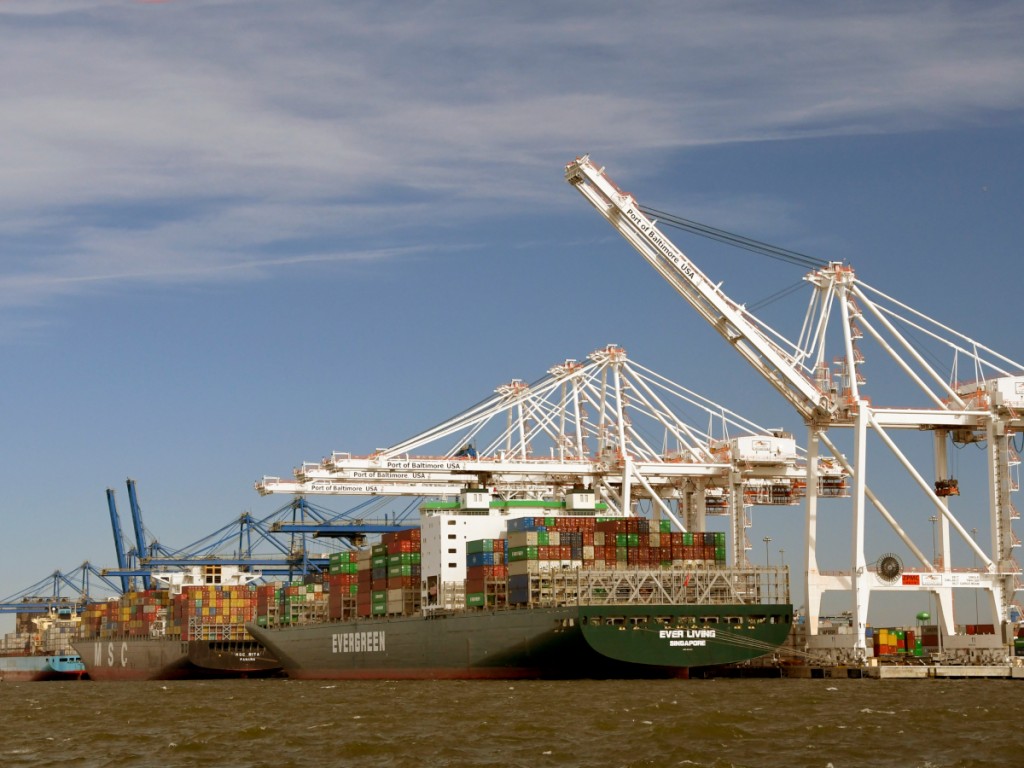With advancement of a long-awaited rail tunnel project and additional 50-foot-depth berthing on the way, the Maryland Port Administration’s Port of Baltimore is positioning to continue its trend of record-setting growth across diverse sectors.

“The diversification of the port is something we’ve been working on for a very long time,” James J. White, the MPA’s executive director, told AJOT. “It was a very successful 2018.”
“That’s pretty impressive,” said White, who has been at the MPA helm for 18 of the past 20 years, having been away from the job only from 2005 to 2007. “The port is performing as we designed it.”

Unfortunately, the Howard Street Tunnel beneath downtown Baltimore also is performing as it was designed – in the late 1800s – meaning double-stacked containers can’t move through it on railcars, creating a bottleneck for intermodal movement in and out of the Port of Baltimore’s container terminal facilities.
Fortunately, the new head of CSX has joined Maryland Gov. Larry Hogan and others, including business and environmental groups, in efforts to finally move forward with improving tunnel clearance.
James M. Foote, who became president and chief executive officer of CSX in December 2017, following the death of E. Hunter Harrison, is supportive of the tunnel project, unlike his predecessor.
CSX has committed $91 million, while the State of Maryland has come up with $147 million and is seeking federal funds through a March U.S. Department of Transportation grant submission for the balance of the cost of the endeavor, now estimated at a total of $466 million to provide clearance for double-stacked containers through the tunnel and under 22 bridges between Baltimore and Philadelphia.
Thanks to advances in construction technology, the project cost has dropped from earlier estimates of as much as $3 billion while the work will have far less impact upon surrounding communities.
Hogan has called the tunnel clearance undertaking “an essential project for the Port of Baltimore, State of Maryland and the entire East Coast,” adding, “Reconstructing the Howard Street Tunnel will create thousands of jobs, open up new trade lanes for the port and improve overall freight rail service across our nation.”
Port officials estimate that a reconstructed tunnel would result in about 80,000 more containers per years moving through the Port of Baltimore, which in 2018 handled a record 627,144 boxes, equating to 1,023,152 twenty-foot-equivalent units.
White said a couple of options are being considered, with one that could be completed within 2 1/2 to three years and the other having a four- to five-year construction timeframe.
“We don’t do well with rail today,” White unabashedly said. “We don’t do well with discretionary cargo moving by rail, specifically because the railroads have to put twice the assets here with the single-stack as opposed to double-stack. Once we get the tunnel done, we’re on a level playing field with the other ports that we compete with for Midwest rail, so we’re very excited about it.”
The Port of Baltimore, with its 50-foot-deep channel and supersized neo-Panamax cranes, already is one of the few facilities on the U.S. East Coast to be able to accommodate megacontainerships with capacities of as many as 11,000 TEUs, and plans are advancing in collaboration with the container terminal’s operator to bring a second 50-foot-deep berth online within 18 months, joining two more berths with 45-foot depths.
The $32.8 million berth project, which upon completion will allow the port to handle two megacontainerships simultaneously, is being paid for via $18.4 million from terminal operator Ports America Chesapeake LLC, $7.8 million from the State of Maryland and a $6.6 million federal grant.
The Panama Canal expansion, which in mid-2016 opened the way for passage of carrier alliances’ larger boxships directly from Asia to the U.S. East Coast, was cited by White as a key to the recent boost in activity at the Port of Baltimore’s Seagirt Marine Terminal, operated under a long-term public-private partnership with Ports America Chesapeake.
“Since the completion of the new sets of locks in Panama, I think all East Coast ports are doing very well, at the expense of the West Coast ports,” White said, noting average annual gains of about 7 1/2 percent to 8 percent in Baltimore’s containerized cargo numbers over the past three years.
“That’s good growth in containerization, and, because we have such a big consumer group here, we think that we’re probably going to benefit more than others,” White continued.
“Before,” he said, “when we were trying to convince a shipowner to come down the [Chesapeake] Bay, when they had their own identity and weren’t doing the vessel-sharing agreements, with eight or nine hours in and eight hours back out, it was a tough sell for us. But now you have one big ship with three or four carriers combined and it makes sense to come up and down the bay rather than taking containers off at another port and trucking or barging them here to where the consumer is.”
Beyond the container front, the Port of Baltimore is enjoying eight consecutive years as the No. 1 U.S. port for handling automobiles and light trucks, with more than 850,000 such units through public and private terminals.
“We’re very proud of that,” White said, adding that, in 2020, the Port of Baltimore anticipates an additional 80,000 to 100,000 cars moving across its docks with Volkswagen joining the roster of automakers using the port. “We’re thinking we’re going to hold onto that position for the foreseeable future.”
The Port of Baltimore’s fastest-growing sector this year, according to White, is that of non-automobile roll-on/roll-off cargos, including heavy farm and construction machinery moved by such manufacturers as Caterpillar, Case and John Deere, as well as project cargo.
“The ro/ro business has finally bounced back this year,” he said. “We’re up about 18 percent. It was the last targeted commodity group that bounced back for us.”
The Port of Baltimore also continues to rank first among U.S. ports in sugar imports and gypsum imports and second in coal exports. Significant volumes of forest products, including rolled paper and wood pulp, further contribute to general cargo activity.
And, in keeping with the success of the MPA’s diversification strategy, the cruise sector also has been performing well at the Port of Baltimore, which is about halfway through its five-year agreements with Carnival and Royal Caribbean lines.
“All indications are that they’re going to remain here,” White said. “We think we’re really in a sweet spot with cruise right now.”




